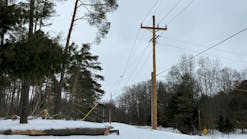Robust customer demand and a growing expectation for uninterrupted service has made live-line barehand work a common practice in the utility industry. Ten years ago, few companies and contractors specialized in barehand work, but today linemen perform it every day. Energized work methods minimize disruption of service to power consumers, which translates into an uninterrupted revenue flow for the utility.
Barehand work on high-voltage lines also is growing for the same reasons. This was once a practice provided by only a few elite contractors and linemen who were certified to work on energized transmission lines. However, the proven safety of working while lines are energized and the cost of taking transmission lines off-line, has resulted in a preference for energized maintenance work on high-voltage lines. This summer a Northeast Utilities (Berlin, Connecticut) project in Massachusetts serves as a good example.
High-Voltage Barehand
Northeast Utilities' subsidiary Western Massachusetts Electric Co. (WMECO) is changing out 14 H-frame wood structures for steel structures on a live 345-kV line from Granby through Pelham, Massachusetts, to Shutesbury, Massachusetts. The project, which is taking place two hours west of Boston, began in June 2008 and is scheduled to be completed in August 2008.
“The beauty of barehand for us is this [345-kV line] is a major section of the grid,” said Carl Tyburski, supervisor of transmission lines and field contract services for WMECO. “We would never be able to get this line out of service this time of year. Barehand also allows us to get the work done in the summer rather than winter when we run into ice loads season.”
Reflective of this trend toward working live, a growing number of linemen are migrating to high-voltage live-line work. These hand-selected teams of experienced journeymen complete significant competency-based training with ongoing annual recertification. Different from distribution barehand work — hot sticking and rubber gloving — transmission live-line work includes an added set of unique and distinguishing work techniques, tools and even safety apparel.
One of the most distinguishing components is “bonding on.” Bonding on or bonding off refers to the fundamental procedures in which barehanders are meticulously trained to perform in order to be placed at the same electrical potential as the energized circuit on which they are working. Even more unique, though, is the barehand suit itself.
The Barehand Suit
The suit worn by barehanders consists of a hooded jacket, bib-overall-style pants, socks and gloves. The suit is made of 75% Nomex (fire-retardant material) and 25% stainless-steel fibers. The Nomex content of the suit qualifies as the outer fire-retardant clothing layer required by most U.S. utilities. The metallic mesh designed into the suit serves as a Faraday Cage, putting the lineman at the same potential as that of the conductor on which he or she is working.
The Faraday Cage principle states that no charge can be present on the interior of a charged cage. While wearing the barehand suit, the electric charge flows around the outside of the suit (the charged cage) and not through the lineman's body (the interior of the charged cage). With the metallic mesh clothing bonded to the conductor, the lineman can work protected inside the electrical field.
Cumbersome and Tight Fitting
Unfortunately, the suits historically have been heavy and cumbersome, and the first models were “one size fits all.” Barehanders wear the same suit year-round as an outer garment. An even bigger problem for barehanders, though, is how difficult it is to take the suit off and on over heavy lineman boots.
Quanta Energized Services' barehand teams have worn the suits since they were developed. The teams who work in the Northeast and in the winter snows in Minnesota were becoming disgruntled about the suit. Tom Burns, a barehand general foreman for Quanta, explains, “In the summer, some barehanders wear shorts and work boots under the suit. In the south, they may even use gel-pack cooling vests, stored in a cooler of ice and worn under the suit to provide cooling action. The real problem is trying to get the suit pants off and on over heavy boots in the winter.”
Taking Off the Suit
Not all of the work on a barehand job requires wearing the suit. When the barehanders need to come down from the bucket or work platform to move the truck or to perform other de-energized work, they can remove the suit. In the wintertime, linemen have to remove their boots to take off the suit, which is inconvenient. And in recent years with the increased demand and acceptance of barehand work, it has become more and more common to work year-round.
Winter Work
In addition to the barehand 345-kV H-frame structures replacement project currently underway in Massachusetts, WMECO and PAR Electrical Contractors Inc. (Kansas City, Missouri), a Quanta subsidiary, worked on another project last year. The companies successfully replaced nearly 1000 in-line and deadend connectors along 115 miles of energized 345-kV transmission line from southern Massachusetts into central Connecticut. Both companies were dedicated to making the line crews comfortable, safe and as efficient as possible.
Quanta also was awarded a master services agreement in 2007 to provide transmission infrastructure services related to its long-range transmission build out. This partnership is expected to extend through 2013. Quanta's Burns, who is serving as the barehand general foreman on the connector replacement project, says, “Because we were able to barehand, we cut 30 months off the estimated completion time mainly by doing it live. And because we worked right through the coldest months of the year, removing the tight suits was a problem.”
The Leg Zipper
Consistent with its reputation for ingenuity, Quanta barehanders recommended that the manufacturers consider adding some type of zipper to the pant legs, similar to the zippers on coveralls worn by sportsmen during cold weather. The traditional barehand suit design is a straight leg with cuts to allow fitting over normal work boots. Neither of the two safety apparel manufacturers that Quanta purchased the suits from offered an easy-to-remove piece of clothing. The linemen's concern and the problem facing the apparel engineers was how to maintain the protective integrity of the suit and the Faraday Cage.
Quanta's division responsible for overseeing the operating units' barehand work took the idea of a leg zipper to Euclid Garment Manufacturing Co. (Kent, Ohio). Euclid's safety apparel engineers responded with a design in which they inserted a zipper from the end of the leg on the outside of the pants up to the knee with a bellows-type strip of fabric under the leg zipper. When the zipper was opened, the leg of the pants opened enough to take them off over large pack boots. The bellows style ensured electrical continuity at all times whether the zipper was opened or closed.
Barehand crews reviewed the prototype and made one final recommendation to lengthen the zipper on the legs. This gave even more room for removal of the pants over the boots. Since only the pants component of the barehand suit was affected, Euclid was able make the modifications. The company worked with crews to retrofit several of the original suits, rotating them in and out of the field.
As the demand for working energized continues to grow, linemen can take comfort in knowing that the suits they must wear to perform high-voltage barehand work are now more comfortable and easy to wear. Thanks to the cooperative effort from the field, the factory and the industry, all of Euclid's standard barehand pants feature the leg zipper. And all of Quanta Services operating units are using the modified barehand suits.
FARADAY CAGE PRINCIPLE
The Faraday Cage principle was developed in the early 1800s by physicist Michael Faraday, who discovered that an enclosure formed by conducting material, or by a mesh of such material, blocks out external static electrical fields.
When an external static electrical field connects with the suit, the conducting material redistributes the charge around the “cage,” canceling the field's effects inside the cage's or suit's interior. One example of this effect is when lightning strikes airplanes. The passengers inside and the plane itself are unharmed because they are protected by the Faraday Cage principle.
BAREHAND IMPROVEMENTS
Many of Quanta's operating units such as Danford Technologies Inc. (Oliver, British Columbia) and PAR Electrical (Kansas City, Missiouri) have pioneered the techniques and proprietary equipment used in barehand work. When the barehanders find a better tool or technique that will add value and safety to a project, they often work with manufacturers and the industry to make it happen.
A good example of this was the LineMaster Robotic Arm developed by a Quanta subsidiary. The LineMaster is a hydraulically powered, boom-mounted, rotating and telescoping robotic arm that can be used for maintaining transmission and distribution facilities live.

